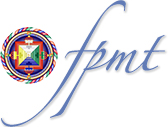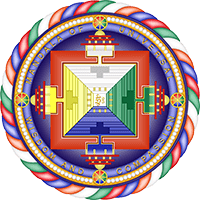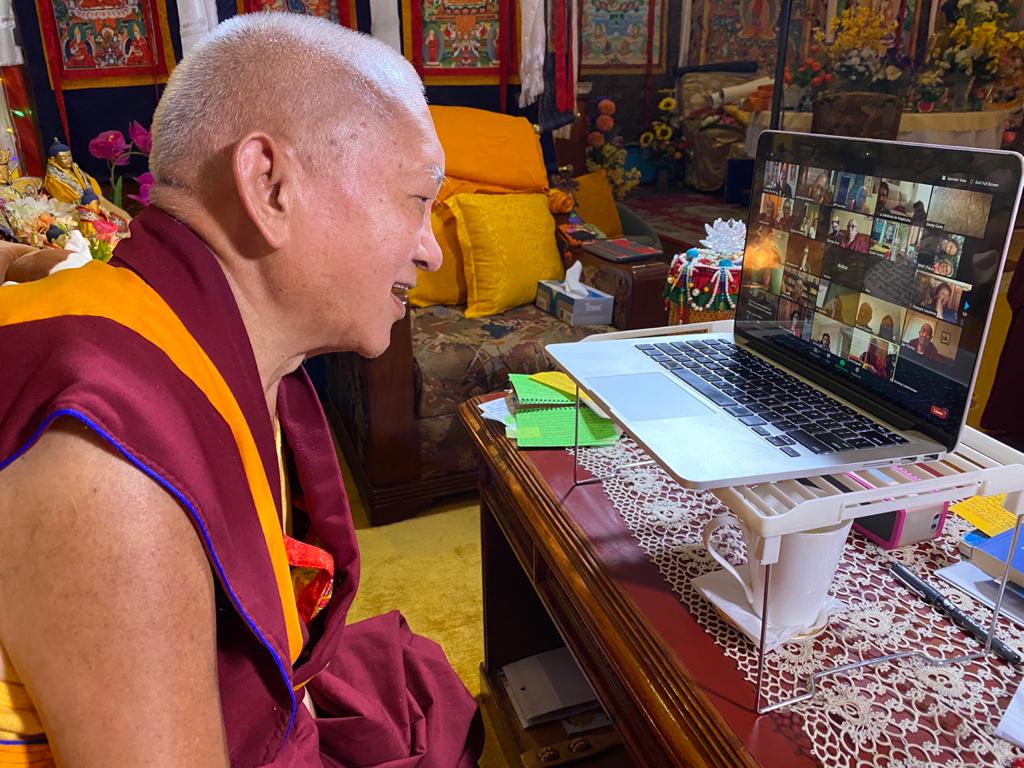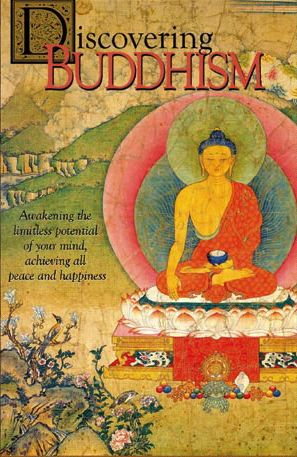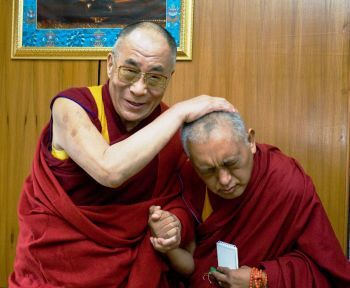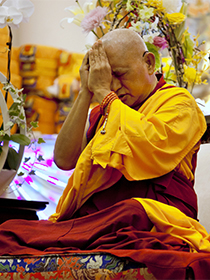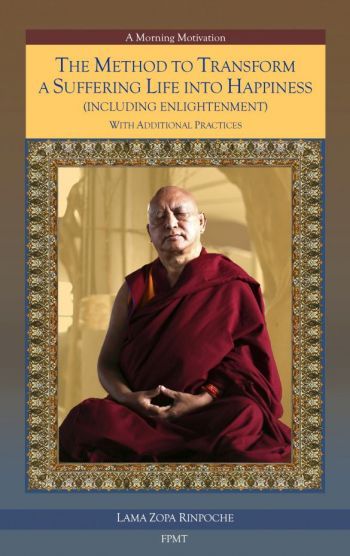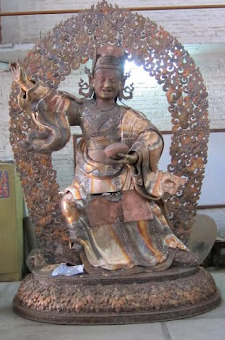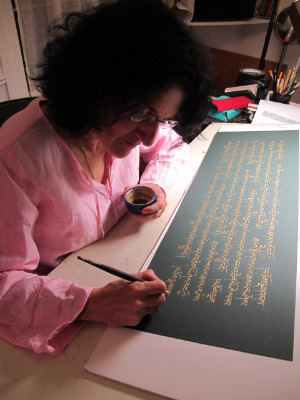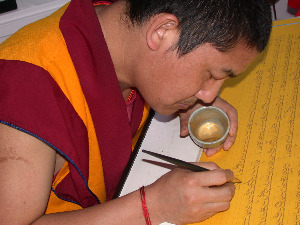- Home
- FPMT Homepage
Foundation for the Preservation of the Mahayana Tradition
The FPMT is an organization devoted to preserving and spreading Mahayana Buddhism worldwide by creating opportunities to listen, reflect, meditate, practice and actualize the unmistaken teachings of the Buddha and based on that experience spreading the Dharma to sentient beings. We provide integrated education through which people’s minds and hearts can be transformed into their highest potential for the benefit of others, inspired by an attitude of universal responsibility and service. We are committed to creating harmonious environments and helping all beings develop their full potential of infinite wisdom and compassion. Our organization is based on the Buddhist tradition of Lama Tsongkhapa of Tibet as taught to us by our founders Lama Thubten Yeshe and Lama Thubten Zopa Rinpoche.
- Willkommen
Die Stiftung zur Erhaltung der Mahayana Tradition (FPMT) ist eine Organisation, die sich weltweit für die Erhaltung und Verbreitung des Mahayana-Buddhismus einsetzt, indem sie Möglichkeiten schafft, den makellosen Lehren des Buddha zuzuhören, über sie zur reflektieren und zu meditieren und auf der Grundlage dieser Erfahrung das Dharma unter den Lebewesen zu verbreiten.
Wir bieten integrierte Schulungswege an, durch denen der Geist und das Herz der Menschen in ihr höchstes Potential verwandelt werden zum Wohl der anderen – inspiriert durch eine Haltung der universellen Verantwortung und dem Wunsch zu dienen. Wir haben uns verpflichtet, harmonische Umgebungen zu schaffen und allen Wesen zu helfen, ihr volles Potenzial unendlicher Weisheit und grenzenlosen Mitgefühls zu verwirklichen.
Unsere Organisation basiert auf der buddhistischen Tradition von Lama Tsongkhapa von Tibet, so wie sie uns von unseren Gründern Lama Thubten Yeshe und Lama Thubten Zopa Rinpoche gelehrt wird.
- Bienvenidos
La Fundación para la preservación de la tradición Mahayana (FPMT) es una organización que se dedica a preservar y difundir el budismo Mahayana en todo el mundo, creando oportunidades para escuchar, reflexionar, meditar, practicar y actualizar las enseñanzas inconfundibles de Buda y en base a esa experiencia difundir el Dharma a los seres.
Proporcionamos una educación integrada a través de la cual las mentes y los corazones de las personas se pueden transformar en su mayor potencial para el beneficio de los demás, inspirados por una actitud de responsabilidad y servicio universales. Estamos comprometidos a crear ambientes armoniosos y ayudar a todos los seres a desarrollar todo su potencial de infinita sabiduría y compasión.
Nuestra organización se basa en la tradición budista de Lama Tsongkhapa del Tíbet como nos lo enseñaron nuestros fundadores Lama Thubten Yeshe y Lama Zopa Rinpoche.
A continuación puede ver una lista de los centros y sus páginas web en su lengua preferida.
- Bienvenue
L’organisation de la FPMT a pour vocation la préservation et la diffusion du bouddhisme du mahayana dans le monde entier. Elle offre l’opportunité d’écouter, de réfléchir, de méditer, de pratiquer et de réaliser les enseignements excellents du Bouddha, pour ensuite transmettre le Dharma à tous les êtres. Nous proposons une formation intégrée grâce à laquelle le cœur et l’esprit de chacun peuvent accomplir leur potentiel le plus élevé pour le bien d’autrui, inspirés par le sens du service et une responsabilité universelle. Nous nous engageons à créer un environnement harmonieux et à aider tous les êtres à épanouir leur potentiel illimité de compassion et de sagesse. Notre organisation s’appuie sur la tradition guéloukpa de Lama Tsongkhapa du Tibet, telle qu’elle a été enseignée par nos fondateurs Lama Thoubtèn Yéshé et Lama Zopa Rinpoché.
Visitez le site de notre Editions Mahayana pour les traductions, conseils et nouvelles du Bureau international en français.
Voici une liste de centres et de leurs sites dans votre langue préférée
- Benvenuto
L’FPMT è un organizzazione il cui scopo è preservare e diffondere il Buddhismo Mahayana nel mondo, creando occasioni di ascolto, riflessione, meditazione e pratica dei perfetti insegnamenti del Buddha, al fine di attualizzare e diffondere il Dharma fra tutti gli esseri senzienti.
Offriamo un’educazione integrata, che può trasformare la mente e i cuori delle persone nel loro massimo potenziale, per il beneficio di tutti gli esseri, ispirati da un’attitudine di responsabilità universale e di servizio.
Il nostro obiettivo è quello di creare contesti armoniosi e aiutare tutti gli esseri a sviluppare in modo completo le proprie potenzialità di infinita saggezza e compassione.
La nostra organizzazione si basa sulla tradizione buddhista di Lama Tsongkhapa del Tibet, così come ci è stata insegnata dai nostri fondatori Lama Thubten Yeshe e Lama Zopa Rinpoche.
Di seguito potete trovare un elenco dei centri e dei loro siti nella lingua da voi prescelta.
- 欢迎 / 歡迎
简体中文
“护持大乘法脉基金会”( 英文简称:FPMT。全名:Foundation for the Preservation of the Mahayana Tradition) 是一个致力于护持和弘扬大乘佛法的国际佛教组织。我们提供听闻,思维,禅修,修行和实证佛陀无误教法的机会,以便让一切众生都能够享受佛法的指引和滋润。
我们全力创造和谐融洽的环境, 为人们提供解行并重的完整佛法教育,以便启发内在的环宇悲心及责任心,并开发内心所蕴藏的巨大潜能 — 无限的智慧与悲心 — 以便利益和服务一切有情。
FPMT的创办人是图腾耶喜喇嘛和喇嘛梭巴仁波切。我们所修习的是由两位上师所教导的,西藏喀巴大师的佛法传承。
繁體中文
護持大乘法脈基金會”( 英文簡稱:FPMT。全名:Found
ation for the Preservation of the Mahayana Tradition ) 是一個致力於護持和弘揚大乘佛法的國際佛教組織。我們提供聽聞, 思維,禪修,修行和實證佛陀無誤教法的機會,以便讓一切眾生都能 夠享受佛法的指引和滋潤。 我們全力創造和諧融洽的環境,
為人們提供解行並重的完整佛法教育,以便啟發內在的環宇悲心及責 任心,並開發內心所蘊藏的巨大潛能 — 無限的智慧與悲心 – – 以便利益和服務一切有情。 FPMT的創辦人是圖騰耶喜喇嘛和喇嘛梭巴仁波切。
我們所修習的是由兩位上師所教導的,西藏喀巴大師的佛法傳承。 察看道场信息:
- FPMT Homepage
- News/Media
-
- Study & Practice
-
-
- About FPMT Education Services
- Latest News
- Programs
- New to Buddhism?
- Buddhist Mind Science: Activating Your Potential
- Heart Advice for Death and Dying
- Discovering Buddhism
- Living in the Path
- Exploring Buddhism
- FPMT Basic Program
- FPMT Masters Program
- FPMT In-Depth Meditation Training
- Maitripa College
- Lotsawa Rinchen Zangpo Translator Program
- Universal Education for Compassion & Wisdom
- Online Learning Center
-
- Prayers & Practice Materials
- Overview of Prayers & Practices
- Full Catalogue of Prayers & Practice Materials
- Explore Popular Topics
- Benefiting Animals
- Chenrezig Resources
- Death & Dying Resources
- Lama Chopa (Guru Puja)
- Lama Zopa Rinpoche: Compendium of Precious Instructions
- Lama Zopa Rinpoche: Life Practice Advice
- Lama Zopa Rinpoche Practice Series
- Lamrim Resources
- Mantras
- Prayer Book Updates
- Purification Practices
- Sutras
- Thought Transformation (Lojong)
- Audio Materials
- Dharma Dates - Tibetan Calendar
- Translation Services
- Publishing Services
- Ways to Offer Support
- Prayers & Practice Materials
-
- Teachings and Advice
- Find Teachings and Advice
- Lama Zopa Rinpoche Advice Page
- Lama Zopa Rinpoche: Compendium of Precious Instructions
- Lama Zopa Rinpoche Video Teachings
- ༧སྐྱབས་རྗེ་བཟོད་པ་རིན་པོ་ཆེ་མཆོག་ནས་སྩལ་བའི་བཀའ་སློབ་བརྙན་འཕྲིན།
- Podcasts
- Lama Yeshe Wisdom Archive
- Buddhism FAQ
- Dharma for Young People
- Resources on Holy Objects
- Teachings and Advice
-
-
*If a menu item has a submenu clicking once will expand the menu clicking twice will open the page.
-
-
- Centers
-
- Teachers
-
- Projects
-
-
-
-
*If a menu item has a submenu clicking once will expand the menu clicking twice will open the page.
-
-
- FPMT
-
-
-
-
-
The sun of real happiness shines in your life when you start to cherish others.
Lama Zopa Rinpoche
-
-
-
- Shop
-
-
-
The Foundation Store is FPMT’s online shop and features a vast selection of Buddhist study and practice materials written or recommended by our lineage gurus. These items include homestudy programs, prayers and practices in PDF or eBook format, materials for children, and other resources to support practitioners.
Items displayed in the shop are made available for Dharma practice and educational purposes, and never for the purpose of profiting from their sale. Please read FPMT Foundation Store Policy Regarding Dharma Items for more information.
-
-
Charitable Activities
16
March 2012: Lama Zopa Rinpoche offered 26 Maitreya Buddha statues to FPMT centers, projects and services that wished to have one. Read more and view a photo gallery created by Mandala magazine!
16
Lama Zopa Rinpoche on Bodhichitta
Practicing Bodhichitta (Audio and Unedited Transcripts)
- Bodhichitta Motivation in Daily Life
- Bodhisattva Attitude: How to Dedicate Your Life to Others
- How to Live with Bodhichitta
- Training the Mind in Bodhichitta
- Lama Zopa Rinpoche teaching on bodhichitta at Bodhgaya stupa (video)
- Living in the Path: Refuge and Bodhichitta
- Discovering Buddhism: How to Develop Bodhichitta
- The Everflowing Nectar of Bodhichitta
- Cooking with Bodhichitta: Lama Zopa Rinpoche’s Momo Recipes
9
Immediate Needs
August 2012: The most immediate need of the Amdo Eye Hospital is to purchase a laser surgery machine (Phacoemulsification machine). The cost for one of these machines is US$120,000. FPMT is currently fundraising in order to be able to sponsor one, which will greatly help the hospital’s efficiency and will directly benefit those needing the surgeries.
The phacoemulsification machine breaks the cataract into tiny pieces and then suctions those pieces from the eye through a very small incision. Prior to the development of the phaco machine, the cataract was normally removed in one piece, requiring a larger incision, sutures, and more trauma to the eye. By having the phacoemulsification machine the whole procedure is much faster, less than 15 minutes per eye, and it allows the patient to walk out of the surgical suite and resume normal activities within a few days.
How Can I Make a Donation?
To make a tax-deductible donation:
Or simply send your check in US dollars payable to FPMT Inc. and write “Amdo Eye Hospital” on the memo line.
FPMT Inc.
1632 SE 11th Avenue
Portland, OR 97214-4702
USA
The Amdo Eye Hospital is a project of FPMT Inc. and is administered by FPMT International Office located in Portland, Oregon, United States. All donations made to this fund are tax-deductible within the United States in accordance with IRS Code article 501(c)(3) to the extent allowed by law.
For more information please contact: Holly Ansett, Charitable Projects Coordinator.
- Tagged: tibet health services project
9
Ven. Pemba Sherpa visits Amdo Eye Hospital and Reports
August 2011: Ven. Pemba Sherpa (FPMT board member, resident teacher and co-director of Cham Tse Ling, in Hong Kong) visited the Amdo Eye Hospital to report on its progress and operations.
Currently there are 24 people working in the hospital, including four doctors and four nurses who visit from the local government hospital a few times a week to perform the actual surgeries. The hospital is three and half stories high and has 36 beds to accommodate patients.
The full price for cataract surgery is about US$750 (4800 CNY), however for patients who cannot afford this, the surgery is offered for free or whatever amount they can manage. At this stage it is not possible to run the hospital totally free of charge, but the plan is to be able to offer more free or low cost surgeries, as the hospital expands.
- Tagged: tibet health services project
9
Amdo Eye Hospital Inauguration
August 2011: The inauguration of the building was in July 2010, it took a year to equip the hospital and get the necessary documents to be able to perform the surgeries and in August 2011 the hospital was officially opened to the public. In the last four weeks the hospital has performed eight surgeries and four of these were offered free. As the hospital becomes better known and receives more funding and equipment it will be able to perform many more surgeries. Currently the hospital is one of the largest hospitals in Xining dedicated solely to performing eye surgery.
Please watch a video of the inauguration of the Amdo Eye Hospital.
- Tagged: tibet health services project
19
Padmasambhava Project for Peace Accomplishments as of July 2012
US$60,000 donated to build large Padmasambhava statue for a monastery in Asia.
Over US$1.6 million offered to build and house 21 statues including:
•A 70-foot (21-meter) statue of Padmasambhava with two consorts, each 25 feet (7.5 meters) high;
•Eighteen life-sized statues including the Eight Aspects of Padmasambhava over 6 feet (2 meters) high
A temple to house the statues utilizing art inspired by Padmasambhava’s experience of the pure land Zangdok Palri (Glorious Copper-Colored Mountain)
US$3,000 donated to build a Padmasambhava statue at Milarepa Center in Vermont, USA between 2 and 3 feet (about 1 meter)– Thanks to a 2009 International Merit Box grant!
US$100,000 offered to build a very large Wish-fulfilling Padmasambhava statue at a Sakya Monastery
Initial planning to build a 120-foot (36.5-meter) Padmasambhava statue in Khakhorin, Mongolia. This project is being undertaken by FPMT Mongolia.
- Tagged: padmasambhava project for peace
12
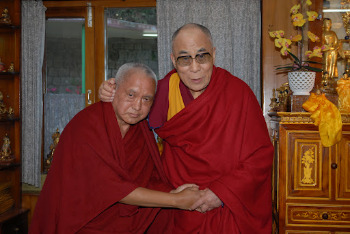
Beginning November 30, 2012 and continuing for 10-15 days, these teachings and transmissions will take place at Gaden Monastery and Drepung Monastery in Doeguling Tibetan Settlement, Mundgod, South India. In the latter part of 2013 His Holiness will continue these teachings and transmissions at Sera Monastery in Lugsung Samdupling Tibetan Settlement, Bylakuppe, South India.
As part of FPMT’s mission to preserve the Mahayana tradition, Lama Zopa Rinpoche has offered for FPMT to support these rare and precious teachings in various ways, including:
- Funding a sound system for the event.
- Printing 50,000 copies of five different texts needed for the teaching event.
- Providing bags for all the texts being offered.
To provide these offerings we need to raise $425,000. Can you help?
July 30, 2012 UPDATE:
Tremendous and heartfelt thanks to all who participated in raising funds for this precious teaching event. We are delighted to report that due to the kindness of many, we have been so far able to raise $350,000!
It has now been confirmed that His Holiness will continue these teachings and transmissions in 2013 at Sera Monastery in Lugsung Samdupling Tibetan Settlement, Bylakuppe, south India (exact dates to be announced).
Also there will a live webcast of the teachings available, for those unable to attend. The website address for the webcast will be announced in the future.
Heartfelt and tremendous thanks to everyone who contributed to raising all the funds needed for the 2012 sponsorship of this event.
Please visit the official website of this event for more information.
How Can I Make a Donation?
To make a tax-deductible donation:
Or simply send your check in US dollars payable to FPMT Inc. and write “Eighteen Great Lam-rim Commentaries Sponsorship” on the memo line.
FPMT Inc.
1632 SE 11th Avenue
Portland, OR 97214-4702
USA
The Preserving the Lineage Fund is a project of FPMT Inc. and is administered by FPMT International Office located in Portland, Oregon, United States. All donations made to this fund are tax-deductible within the United States in accordance with IRS Code article 501(c)(3) to the extent allowed by law.
For more information please contact: Charitable Projects Coordinator.
- Tagged: preserving the lineage fund
29
A Request I Couldn’t Refuse
By Jane Seidlitz
So I practiced my Tibetan writing for about six months in black ink, at the end of which I sent a sample to Rinpoche for assessment. Evidently passing the test, I got the go ahead to start writing in gold.
Since then, I have worked more or less steadily – depending on my work schedule and other life distractions. To date I have written 320 pages of what will be about 1400 pages in total. Eventually the text will go in the heart of the Maitreya statue to be built in India. My hope is always to write a page a day, which doesn’t often happen. But even if I only write a few lines, or even one letter, it feels worthwhile, and of course every time I set pen to paper I remember what Rinpoche told me about the benefits.
I spent a long time in the beginning looking at many examples to try and make my writing as beautiful and accurate as possible. At that point, writing a page took about seven hours. Gradually, my writing style has coalesced and I can write a page in about half that time. In 2001, when I went to Mongolia with Rinpoche, my job for three weeks was to stir the gold for Rinpoche every night – sometimes all night – while Rinpoche wrote the Prajnaparamita. That was truly magical – I felt like I was living one of those stories from centuries past, the kind we hear about in the teachings. But it didn’t occur to me that I would end up some years later doing the writing myself!
I feel tremendously blessed and grateful that Rinpoche has given me this amazing project. My hope is to finish well before I die, to create the cause to realize emptiness – the subject of the text – as quickly as possible, and for whatever merit is created through the writing, to fulfill all of Rinpoche’s holy wishes.
- Tagged: prajnaparamita project
28
Ven. Tsering Dedicates His Life to Prajnaparamita Project
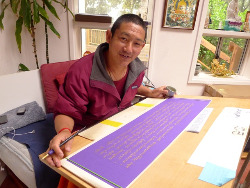
Ven. Tsering’s Progress
Ven. Tsering began writing the 12 volume Prajnaparamita in early 2002.
In 2006 he finished the first volume– about 800 pages.
Ven. Tsering finished the second volume in 2011– approximately 700 pages.
July 2012: He is currently halfway through the fourth volume (Jane Seidlitz is writing out the third volume).
About his work, Ven. Tsering says he, “feels very honored and fortunate to be doing this project.”
- Tagged: prajnaparamita project
6
Recent Disbursements
The Stupa Fund supports the making of over 1,000 small Kadampa stupas each year. These stupas are made by resident Sangha at Lama Zopa Rinpoche’s home in California and are dedicated for students who have passed away.
The fund has also recently pledged a total of US$51,000 to the Stupa Project at Land of Medicine Buddha, California, USA.
- Tagged: stupa fund
1
Sera Je Food Fund Videos
June 2012: We are delighted to present you with new videos which help illustrate the many benefits of this project.
“A Brief Introduction to the Sera Je Food Fund” is a short introduction and overview of the project.
“The Making of Food” is 23-minute video providing a virtual tour of how the food is prepared for all 2,600 monks at Sera Je Monastery.
All Sera Je Food Fund videos can be found on our new video page on the Sera Je Food Fund web page.
1
Sera Je Food Fund’s New Videos!
June 2012: We are delighted to present you with new videos which help illustrate the many benefits of this project.
“A Brief Introduction to the Sera Je Food Fund” is a short introduction and overview of the project.
“The Making of Food” is 23-minute video providing a virtual tour of how the food is prepared for all 2,600 monks at Sera Je Monastery.
All Sera Je Food Fund videos can be found on our new video page on the Sera Je Food Fund web page.
Normal
0
false
false
false
EN-US
X-NONE
X-NONE
/* Style Definitions */
table.MsoNormalTable
{mso-style-name:”Table Normal”;
mso-tstyle-rowband-size:0;
mso-tstyle-colband-size:0;
mso-style-noshow:yes;
mso-style-priority:99;
mso-style-qformat:yes;
mso-style-parent:””;
mso-padding-alt:0in 5.4pt 0in 5.4pt;
mso-para-margin-top:0in;
mso-para-margin-right:0in;
mso-para-margin-bottom:10.0pt;
mso-para-margin-left:0in;
line-height:115%;
mso-pagination:widow-orphan;
font-size:11.0pt;
font-family:”Calibri”,”sans-serif”;
mso-ascii-font-family:Calibri;
mso-ascii-theme-font:minor-latin;
mso-fareast-font-family:”Times New Roman”;
mso-fareast-theme-font:minor-fareast;
mso-hansi-font-family:Calibri;
mso-hansi-theme-font:minor-latin;}
We are delighted to present you with new videos which help illustrate the many benefits of this project.
“A Brief Introduction to the Sera Je Food Fund” is a short introduction and overview of the project.
“The Making of Food” is 23-minute video providing a virtual tour of how the food is prepared for all 2,600 monks at Sera Je Monastery.
All Sera Je Food Fund videos can be found on our new video page on the Sera Je Food Fund web page. [CR1]
[CR1]Link to video page
- Home
- News/Media
- Study & Practice
- About FPMT Education Services
- Latest News
- Programs
- New to Buddhism?
- Buddhist Mind Science: Activating Your Potential
- Heart Advice for Death and Dying
- Discovering Buddhism
- Living in the Path
- Exploring Buddhism
- FPMT Basic Program
- FPMT Masters Program
- FPMT In-Depth Meditation Training
- Maitripa College
- Lotsawa Rinchen Zangpo Translator Program
- Universal Education for Compassion & Wisdom
- Online Learning Center
- Prayers & Practice Materials
- Overview of Prayers & Practices
- Full Catalogue of Prayers & Practice Materials
- Explore Popular Topics
- Benefiting Animals
- Chenrezig Resources
- Death & Dying Resources
- Lama Chopa (Guru Puja)
- Lama Zopa Rinpoche: Compendium of Precious Instructions
- Lama Zopa Rinpoche: Life Practice Advice
- Lama Zopa Rinpoche Practice Series
- Lamrim Resources
- Mantras
- Prayer Book Updates
- Purification Practices
- Sutras
- Thought Transformation (Lojong)
- Audio Materials
- Dharma Dates – Tibetan Calendar
- Translation Services
- Publishing Services
- Teachings and Advice
- Find Teachings and Advice
- Lama Zopa Rinpoche Advice Page
- Lama Zopa Rinpoche: Compendium of Precious Instructions
- Lama Zopa Rinpoche Video Teachings
- ༧སྐྱབས་རྗེ་བཟོད་པ་རིན་པོ་ཆེ་མཆོག་ནས་སྩལ་བའི་བཀའ་སློབ་བརྙན་འཕྲིན།
- Podcasts
- Lama Yeshe Wisdom Archive
- Buddhism FAQ
- Dharma for Young People
- Resources on Holy Objects
- Ways to Offer Support
- Centers
- Teachers
- Projects
- Charitable Projects
- Make a Donation
- Applying for Grants
- News about Projects
- Other Projects within FPMT
- Support International Office
- Projects Photo Galleries
- Give Where Most Needed
- FPMT
- Shop
Translate*
*powered by Google TranslateTranslation of pages on fpmt.org is performed by Google Translate, a third party service which FPMT has no control over. The service provides automated computer translations that are only an approximation of the websites' original content. The translations should not be considered exact and only used as a rough guide.If you have fear of some pain or suffering, you should examine whether there is anything you can do about it. If you can, there is no need to worry about it; if you cannot do anything, then there is also no need to worry.
